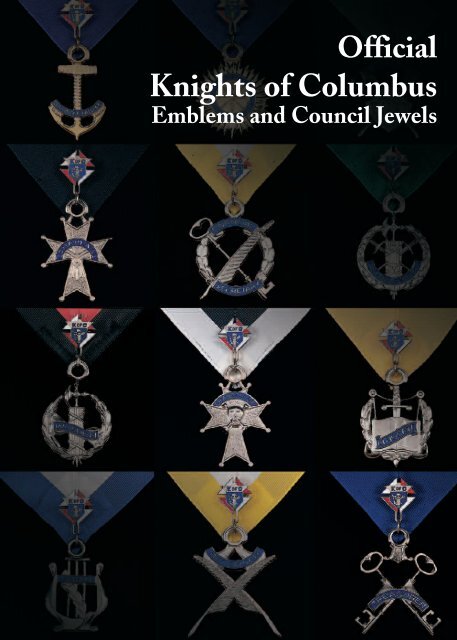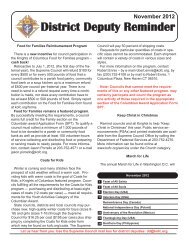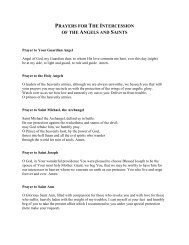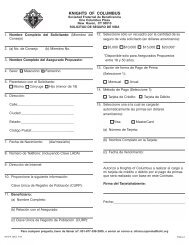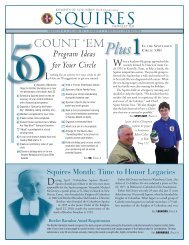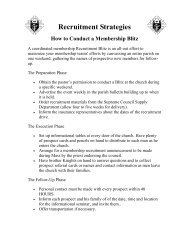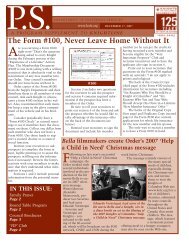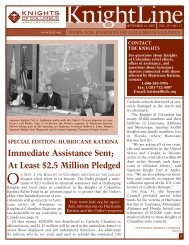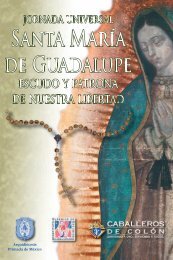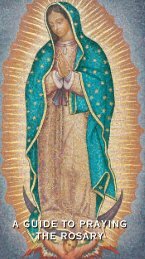Official Knights Of Columbus Emblems And Council Jewels
Official Knights Of Columbus Emblems And Council Jewels
Official Knights Of Columbus Emblems And Council Jewels
You also want an ePaper? Increase the reach of your titles
YUMPU automatically turns print PDFs into web optimized ePapers that Google loves.
<strong><strong>Of</strong>ficial</strong><br />
<strong>Knights</strong> of <strong>Columbus</strong><br />
<strong>Emblems</strong> and <strong>Council</strong> <strong>Jewels</strong>
This booklet contains the official description of<br />
the <strong>Emblems</strong> of the <strong>Knights</strong> of <strong>Columbus</strong>, the<br />
Fourth Degree and the Columbian Squires, along<br />
with the <strong>Jewels</strong> of the <strong>Of</strong>fice for councils, as<br />
approved by the Order’s Board of Directors.<br />
SUPREME KNIGHT
KNIGHTS OF COLUMBUS EMBLEM<br />
The emblem of the Order dates from the second Supreme<br />
<strong>Council</strong> meeting May 12, 1883, when it was designed by James<br />
T. Mullen, who was then Supreme Knight.<br />
A quick glance at the emblem indicates a shield mounted upon<br />
the Formée Cross. The shield is that associated with a medieval<br />
Knight. The Formée Cross is the representation of a traditionally<br />
artistic design of the Cross of Christ through which all graces<br />
of redemption were procurred for mankind. This then represents<br />
the Catholic spirit of the Order.<br />
Mounted on the shield are three objects: a fasces standing vertically,<br />
and, crossed behind it, an anchor and a dagger or short sword.<br />
The fasces from Roman days is symbolic of authority which must<br />
exist in any tightly-bonded and efficiently operating organization.<br />
The anchor is the mariner’s symbol for <strong>Columbus</strong>, patron of the<br />
Order, while the short sword or dagger was the weapon of the<br />
Knight when engaged upon an errand of mercy. Thus, the shield<br />
expresses Catholic Knighthood in organized merciful action, and<br />
with the letters, K. of C., it proclaims this specific form of activity.<br />
The red, white and blue in the background of the shield and the<br />
foreground of the Cross of Malta are the colors of our country. As<br />
such, red is the symbol of stout-hearted courage, of pulsing activity<br />
and a full measure of devotion. Blue is the symbol of hope, of<br />
calm tranquility under God and of confidence in the protection of<br />
our country. White is the symbol of nobility of purpose, of purity<br />
of aim and of crucible — tried ideals to be carried out.<br />
But there is another symbolism of color in red, white and blue.<br />
This is the ecclesiastical symbolism in which red becomes
the reflection of the drips of Christ’s redemptive blood shed<br />
upon Calvary, and of the martyr’s blood shed in defense of<br />
the faith.<br />
Red then is the symbol of Faith, of belief in Christ, in the<br />
Redemption and in the knowledge and love of Jesus Christ.<br />
White is the color of the Eucharistic Host, pledge of God’s<br />
Eucharistic presence among men, of the infinite love God has<br />
for man and the overwhelming affection which the<br />
God-man has for each individual. White then is the symbol of<br />
Christ-like Charity. Blue is the color of Our Lady’s mantle, in<br />
which she wrapped her beloved Son, through Whom came<br />
salvation to a sinful world. Blue is then the symbol of Hope.
THE GRAND KNIGHT — The Anchor, indicative of<br />
<strong>Columbus</strong>, the Mariner. The anchor has also been a<br />
variant form of the Cross for centuries.
CHAPLAIN — Isabella Cross in silver and blue. Self<br />
explanatory.
THE DEPUTY GRAND KNIGHT — The Compass.<br />
Also used by <strong>Columbus</strong>, the Mariner. (The <strong>Knights</strong><br />
of <strong>Columbus</strong> Compass is known as the Compass of<br />
Virtue, its 32 flame-like rays representing the 32<br />
virtues which may be possessed by men.)
THE CHANCELLOR — The Isabella Cross, with Skull<br />
and Crossbones. The cross is self-explanatory while<br />
the skull and crossbones are symbolic of man’s mortality.
THE RECORDER — Crossed quills. Symbolic of his<br />
responsibilities for letter and document (records)<br />
writing and preservation.
THE FINANCIAL SECRETARY — Crossed key and quill.<br />
The key has always been associated with an officer<br />
concerned with money, safe-keeping and secrecy. The<br />
quill is the symbol of a “scribe” — a record-keeper —<br />
one who writes letters, documents, etc.
THE TREASURER — Crossed Keys. Symbolic of his<br />
complete authority over funds (money), particularly<br />
responsible for its safekeeping.
LECTURER — Lyre and Scroll. These are traditionally<br />
symbolic of music and literature and the arts. Hence<br />
the lecturer is in charge of entertainment.
THE ADVOCATE — The Scroll (legal literature and<br />
law) with sword (the power to defend and enforce<br />
the law).
THE WARDEN — An axe bound with rods, known as<br />
a fasces, traditionally carried by the guards or protectors<br />
of Roman magistrates as a symbol of authority.<br />
The warden, ideally, has and exercises that authority.
THE INSIDE GUARD — Crossed Axes and Key. Key is<br />
symbolic of a guardian, secrecy and responsibility for<br />
safekeeping and admission. Axe is indicative of<br />
authority even to the point of punishment to maintain<br />
it. Originally, the axe was symbolic of power<br />
over life and death.
THE OUTSIDE GUARD — Crossed Axes and Key. Key is<br />
symbolic of a guardian, secrecy and responsibility for<br />
safekeeping and admission. Axe is indicative of<br />
authority even to the point of punishment to maintain<br />
it. Originally, the axe was symbolic of power<br />
over life and death.
TRUSTEE — An anchor mounted on an axe bound<br />
with rods (fasces) over crossed swords. Symbolizes<br />
<strong>Columbus</strong>, authority and the power to defend and<br />
enforce the law.
FOURTH DEGREE EMBLEM
FOURTH DEGREE EMBLEM<br />
The triad emblem of the Fourth Degree features the Dove, the<br />
Cross and the Globe. The Dove — classic symbol of the Holy<br />
Spirit and Peace — is shown hovering over the orb of the earth<br />
(Globe). Both are mounted on a variation of the Crusader’s<br />
Cross — that which was found on the tunics and capes of the<br />
Crusading <strong>Knights</strong> who battled to regain the Holy Land from<br />
the pagans.<br />
Our Honored Order cherishes as its patron Christopher<br />
<strong>Columbus</strong>.<br />
Christopher — Christ Bearer.<br />
<strong>Columbus</strong> — Dove of Peace, symbolizing the Paraclete.<br />
Spiritually, the sacred symbols on the emblem typify the Union<br />
of the Three Divine Persons in one Godhead — the most<br />
Blessed Trinity.<br />
The Globe — God the Father, Creator of the Universe.<br />
The Cross — God the Son, Redeemer of Mankind.<br />
The Dove — God the Holy Spirit, Sanctifier of Humanity.<br />
The colors of the symbols are:<br />
A blue Globe with the lands of the Western Hemisphere in<br />
white.<br />
A red Cross with gold borders, and gold knobs at the end of the<br />
points forming the ends of the arms of the Cross (also known<br />
as the Isabella Cross).<br />
A white dove.<br />
Red, white and blue are the colors of the flag of the country in<br />
which our Order originated; and are used to stress the basic<br />
principal of the Fourth Degree...PATRIOTISM.
THE COLUMBIAN SQUIRES EMBLEM — Letters on the<br />
arms of the Maltese Cross represents: “P” — physical<br />
development; “I” — intellectual development; “S” —<br />
spiritual growth and practice of our faith; and “C” —<br />
development of citizenship and civic life. The large letters<br />
represent; “C: — Christ; “S” — Squires; and “K” —<br />
<strong>Knights</strong> of <strong>Columbus</strong>. The Squires motto “Esto Dignus,’<br />
is Latin for “Be Worthy.”
1910 4/11 Printed in U.S.A.


